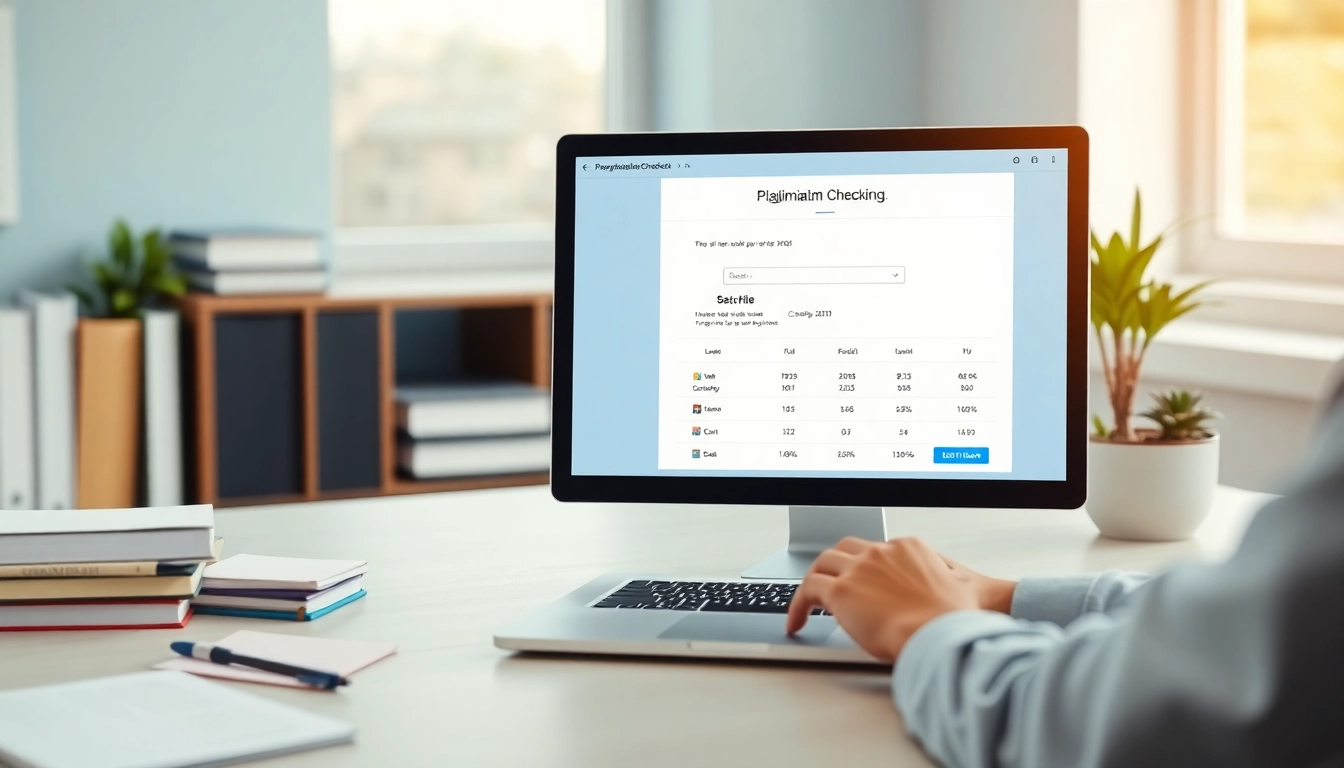Enhance Your Writing with an Efficient Plagiarism Checker Tool
Understanding the Importance of a Plagiarism Checker
In an age where information is readily available and the line between inspiration and theft can blur, the role of a plagiarism checker has never been more vital. Whether you are a student, a professional writer, or an educator, understanding the implications of plagiarism and how to avoid it can protect your credibility and integrity. This section will explore the fundamental aspects of plagiarism and why plagiarism checkers are indispensable tools for anyone involved in writing.
The Basics of Plagiarism and Its Implications
Plagiarism is defined as the act of using someone else’s work, ideas, or expressions without proper acknowledgment. This can include copying text, paraphrasing without attribution, or presenting another’s work as your own. The implications of plagiarism can be severe, leading to academic penalties, professional repercussions, and damage to reputation. In academia, plagiarism can result in expulsion or failure. In the professional realm, it can lead to job loss, legal action, and loss of credibility. Therefore, recognizing what constitutes plagiarism is the first step toward responsible writing.
Why Every Writer Needs a Plagiarism Checker
Every writer, regardless of their level of expertise, should utilize a plagiarism checker for several reasons. Firstly, it ensures originality, which is essential for building a trustworthy brand or reputation. Secondly, it helps maintain academic integrity, especially for students who must ensure their work adheres to ethical standards. Lastly, plagiarism checkers can enhance confidence; knowing your work is original allows you to present it with pride. Moreover, writers exploring collaborative projects or ghostwriting endeavors can benefit from plagiarism checkers to verify the originality of source materials.
How a Plagiarism Checker Protects Your Work
A plagiarism checker serves as a safeguard against the inadvertent copying of material. These tools use advanced algorithms that scan texts for similarities with existing sources on the internet or within databases. By providing a report that highlights possible areas of concern, a plagiarism checker aids in revising work to ensure it meets originality standards. This not only protects the writer from potential repercussions but also upholds the quality and integrity of the written material.
How to Choose the Right Plagiarism Checker
With a plethora of plagiarism checkers available, selecting the right one can seem daunting. However, focusing on key features, understanding the differences between free and paid versions, and considering user experiences can simplify this process.
Key Features to Look for in a Plagiarism Checker
The effectiveness of a plagiarism checker often hinges on its features. Here are some crucial aspects to evaluate:
- Database Size: A large database enhances the tool’s ability to detect plagiarism, as it has more sources to compare against.
- Accuracy: Look for tools that provide comprehensive reports detailing matches and paraphrases, helping identify areas for revision.
- Speed: Efficient tools deliver results quickly, which is essential for meeting tight deadlines.
- User-Friendly Interface: A straightforward interface can significantly enhance the user experience, especially for those who are not tech-savvy.
- Support for Various Formats: Ensure the tool can check multiple file types, including Microsoft Word and PDF files.
Free vs. Paid Plagiarism Checker Tools
Both free and paid plagiarism checkers have their merits. Free tools are beneficial for casual users or initial drafts, offering basic functionality without financial commitment. However, while effective, they often lack the comprehensive databases and features found in paid versions. Paid tools usually provide more accurate reports, advanced functionalities like grammar checks, and customer support, making them ideal for professional needs or extensive academic work. Weighing the costs against the potential risks of plagiarism helps in making an informed choice.
User Experience and Reviews of Plagiarism Checkers
User reviews serve as a valuable resource for assessing the effectiveness of different plagiarism checkers. Positive feedback on accuracy, usability, and customer support can guide choices, while red flags such as frequent inaccuracies or poor customer service should lead to reconsideration. Before committing to a particular tool, consider trial versions when available, allowing firsthand experience of user interface and functionality.
How to Use a Plagiarism Checker Effectively
Using a plagiarism checker effectively requires understanding how to input data, interpret results, and take corrective actions. This section provides a comprehensive guide to maximizing the benefits of these tools.
Step-By-Step Guide to Utilizing a Plagiarism Checker
- Choose the Right Tool: Select a plagiarism checker that meets your specific needs based on previous evaluations of features.
- Input Your Text: Copy and paste your text directly into the designated area, or upload it as a file if the feature is available.
- Run the Check: Activate the plagiarism check, allowing the tool to scan and analyze your content against its database.
- Review the Report: Analyze the results carefully. Look for highlighted sections where potential plagiarized content appears and check for paraphrased material as well.
- Revise as Necessary: Based on the report, make the necessary modifications to improve originality, whether by rephrasing, quoting, or adding citations.
- Re-Check if Needed: Consider running a final check after revisions to ensure all potential issues have been addressed.
Tips for Accurate Results When Using a Plagiarism Checker
To enhance accuracy when using a plagiarism checker, consider the following tips:
- Use clear, concise language that minimizes the risk of common phrases being marked as plagiarism.
- Include proper citations throughout your work, which can prevent unnecessary matches in the first place.
- Check multiple times; running your work through different checkers can provide diverse perspectives and spot unique issues.
Common Mistakes to Avoid with Plagiarism Checker Tools
Some common pitfalls can impede the effectiveness of plagiarism checkers:
- Overlooking Source Attribution: Failing to cite sources can lead to serious plagiarism issues. Ensure all references are included and correctly formatted.
- Ignoring Reports: Disregarding flagged sections could lead to future complications. Pay attention to recommendations provided in the report.
- Relying Solely on Technology: While automation is helpful, manual checks and personal understanding of plagiarism are irreplaceable for thorough assurance.
Advanced Features of Modern Plagiarism Checkers
As technology advances, plagiarism checkers have evolved to offer a range of sophisticated features. Understanding these capabilities can significantly improve how you protect your work.
AI Technology in Plagiarism Checkers
Many modern plagiarism checkers now integrate artificial intelligence that enhances their accuracy and efficiency. These advanced solutions can evaluate writing styles, understand context, and even discern between paraphrasing and original content. AI-driven tools often provide detailed insights about writing patterns, further aiding in the identification of potential issues that may not be immediately obvious through traditional keyword searches.
Custom Reports from a Plagiarism Checker
Custom reports can significantly enhance a writer’s ability to understand their plagiarism check results. These reports often break down the level of similarity per section and suggest specific areas for improvement. Some platforms allow customization of the report format, letting users emphasize different metrics based on their particular needs or preferences.
Integration with Other Writing Tools
Compatibility and integration with other writing applications can streamline the writing process. Many plagiarism checkers can connect seamlessly with word processors, grammar checkers, and content management systems. These integrations not only save time but also ensure that writers have immediate access to tools that enhance their writing’s quality and originality directly within their workspace.
Measuring Success After Using a Plagiarism Checker
Once a plagiarism check is complete, the focus shifts to interpreting results and ensuring those findings contribute to improved writing. This section covers how to analyze the outcome of a plagiarism check effectively.
Analyzing Results from a Plagiarism Checker
Carefully analyzing the results from a plagiarism checker is critical to understanding the uniqueness of your work. Start by categorizing the flagged content; distinguish between unintentional similarities, commonly used phrases, and cases that genuinely require citation. Each flagged instance is an opportunity to enhance your writing and emphasize your unique voice while ensuring accountability for ideas and sources utilized.
Improving Your Writing Post-Plagiarism Check
Utilizing plagiarism check reports can serve as a powerful tool for enhancing your writing. After making adjustments, consider enhancing your original content with research, adding unique examples, or employing a fresh perspective on a topic. Learning from the feedback provided by these reports allows writers to refine their skills continuously, promoting better writing practices in future projects.
Sharing and Collaboration with Plagiarism Checker Reports
For collaborative projects, sharing results from a plagiarism checker can foster transparency among team members. Providing access to the reports can facilitate discussions on how to enhance originality while educating collaborating writers about the importance of proper citation and attribution practices. Collaboration becomes more productive when team members align on expectations regarding originality and ethical writing standards.










